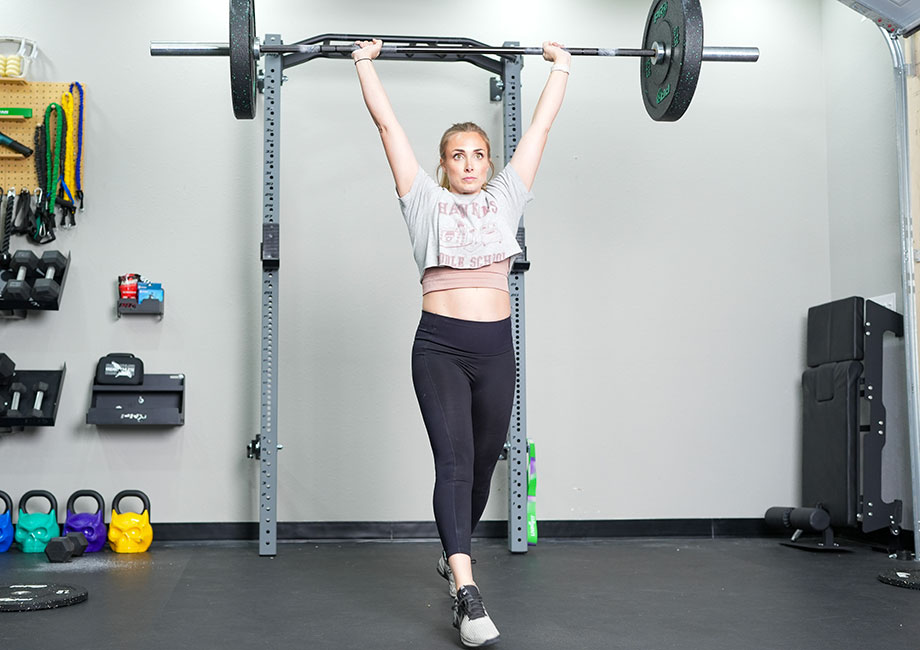We test and review fitness products based on an independent, multi-point methodology. If you use our links to purchase something, we may earn a commission. Read our disclosures.
You may have seen the clean and jerk in a CrossFit box or watched an Olympic weightlifting competition on TV or in person. It’s one of the two official Olympic lifts used in competition (the other being the snatch exercise). So, how is it done? Essentially, the lifter explosively moves a heavy barbell from the floor to the front rack position and ends in the overhead position using the push press exercise for momentum.
GGR staff writer Caine Wilkes, OLY, USAW-L1, just so happens to be an Olympic weightlifter himself. When asked his thoughts on the clean & jerk, he shares, “Many athletes will say a good performance in the snatch will keep you in the competition, but the clean and jerk is where you will win the competition. Being the second lift of the competition, it’s where competitors can gain ground to lift the best total.”
If you think that sounds pretty dang cool and want to dabble in the Olympic lifts—or learn how to move heavy weights smoothly and powerfully from the floor to overhead—then this is the “how-to” for you. Here, I’ll go into the proper technique for the clean and jerk, expert form tips, and the benefits of incorporating this weightlifting movement into your training program. You may not be ready to set the next world record quite yet, but I believe you can get there.
How to Do the Clean and Jerk
The clean & jerk is a complex exercise with many moving parts. Here, I—a certified personal trainer—will walk you through the step-by-step of this complex movement from the starting position to pushing the bar overhead.
- Start in the standing position with a loaded barbell in front of your shins, and your feet set hip-width apart and turned slightly out.
- Hinge down like you would for a deadlift using a hook grip slightly wider than shoulder-width apart. Your shoulders should be slightly forward from the barbell and hips lower than shoulder level.
- Begin the first pull (almost like a deadlift). The first pull starts when the barbell breaks the floor and ends when the barbell passes your knees. Ensure a neutral spine and keep your core tight.
- The momentum from the first pull sets up the second pull. Once the barbell passes your knees, drive your hips forward and pull the barbell up and close to the body. (Some like to bump the barbell with their quads, but that’s a matter of personal preference.)
- Then, rotate the elbows underneath the barbell as you pull yourself under the bar to prepare to catch it.
- Catch the barbell in the front rack position and elbows pointed forward in the bottom of the position, then squat till lockout. From there, smoothly dip down your knees in preparation for the jerk.
- Here, you can go one of three ways: the split jerk, the squat jerk, and the power jerk, which is better for beginners. The power jerk is a push press where you drop down into a quarter squat after driving the bar up with the legs.
- Lock out your elbows, pause at the bottom of the jerk, hold this until the weight feels balanced, and then stand up.
- Reverse to the starting position, reset, and repeat for desired reps.
Expert tip: Before attempting this exercise, ensure you have performed a proper warm-up.
RELATED: Best Warm-Up Exercises
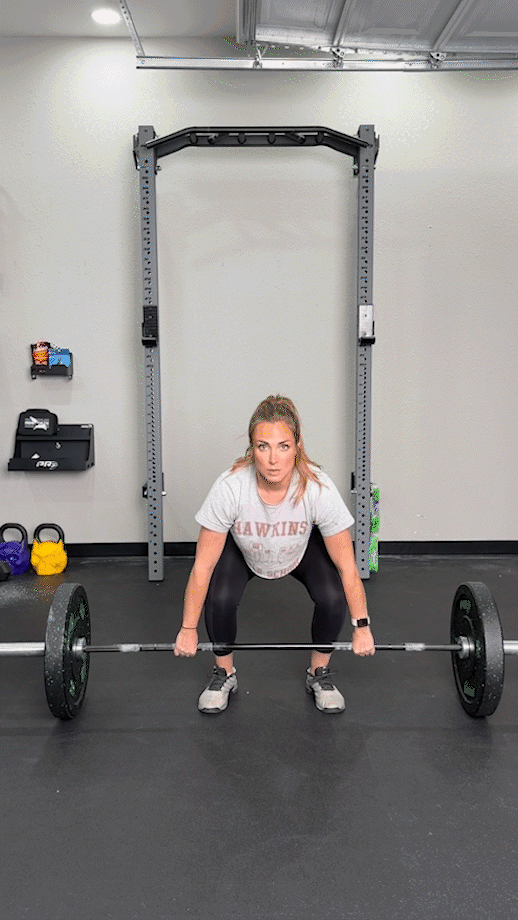
Trainer Tips for Form
There are multiple steps involved in the clean & jerk, and here are some trainer tips for form to clear up any confusion you have about this fantastic lift.
Take the Time to Set Up
The clean and jerk is a total body strength exercise involving the lower and upper body, so ensuring a good starting position is crucial. Set up like you would for the deadlift, except have the bar touching your shins, shoulders forward from the bar, and hips lower than shoulder level.
Generate Momentum
The first pull is all about generating power and momentum for the explosive second pull. Think deadlift, but only faster.
Keep the Bar Close
During the second pull, once the barbell is past your knees, keep it close to your body as you prepare to pull underneath the bar to assume the front rack position. You can brush the bar with the quads, but contact should be minimal so the barbell doesn’t bump away from you. “Fun fact: the clean got its name from old technical rules. Before the 1960s and ’70s, the barbell couldn’t touch the athlete’s body during the pull of a lift, so the pull to the shoulders had to ‘cleanly’ move from the floor to the shoulders without making contact with the rest of the athlete’s body. The more you know!” adds Caine.
Elbows and Chest Up
Once you pull yourself under the bar, catch the bar in the bottom of the front squat position with your elbows and chest up and upper back engaged.
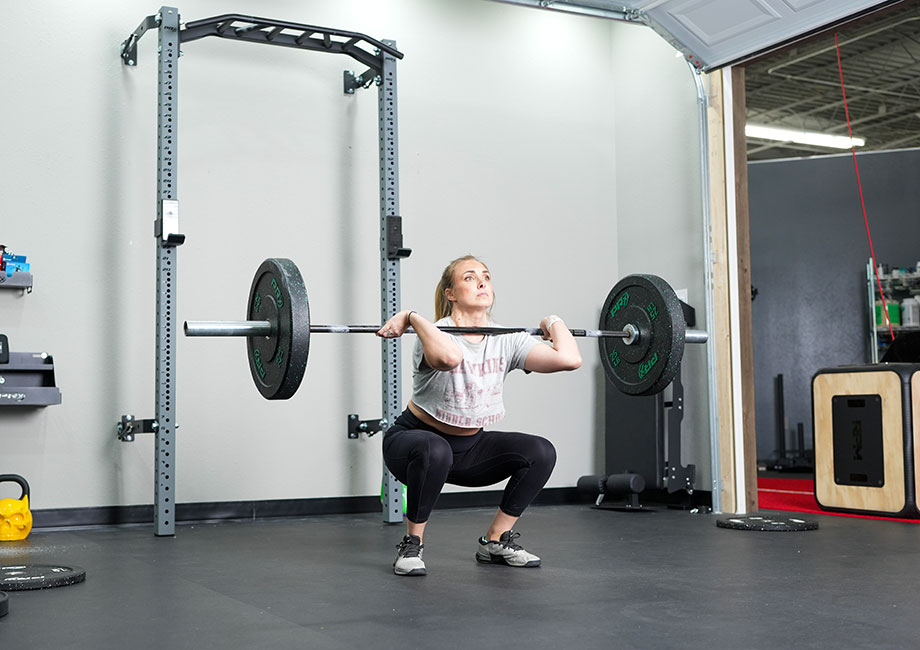
Keep It Smooth
Dip your knees smoothly in preparation for the power or split jerk, and initiate the leg drive by thinking about pushing everything you have through the bar to get it overhead. Only stand up straight when you have stabilized the barbell in the overhead jerk position. Caine says, “Lots of people can clean a lot of weight, but successfully completing a jerk after the clean is what counts in a competition. The jerk is so important that many countries name the clean and jerk just the second half of the term: the jerk.”
Clean and Jerk: Muscles Worked
The clean and jerk trains multiple muscle groups throughout your body:
- Glutes and Hamstrings: The glutes are involved in the hip drive during the first and second pulls, with the hamstrings assisting during the second pull
- Quadriceps: Your quads are trained during the front squat and the dip and drive movement of the clean and jerk.
- Upper Back and Traps: The upper back and traps are involved in the pulling, squatting, and jerk movements.
- Chest, deltoids, and triceps: Although the leg drive gets the barbell overhead, your upper chest, deltoids, and triceps are involved in pushing and stabilizing the weight overhead.
- Forearms and biceps: These arm muscles assist your upper back and traps in the first and second pull.
RELATED: Chest, Shoulders, and Triceps Workout
Clean and Jerk Benefits
The clean and jerk is a technical lift that takes a bit to master, but once you have the basics down, you should expect to see tremendous benefits.
Improved Strength and Power
You must be strong and powerful at every phase of this exercise—from the first pull off the floor to the second pull to the hip drive to the squat or split jerk. Each muscle trained with the clean and jerk will be trained to the max, leading to better muscle hypertrophy and total body strength and power.
Builds Core Strength
Total body explosive exercises like the clean and jerk will build insane core strength because of the demand it puts on the anterior and posterior core. Keeping the spine neutral, transferring power from the lower to the upper body, and stabilizing heavy weights overhead require your core to be at the top of its game the entire time.
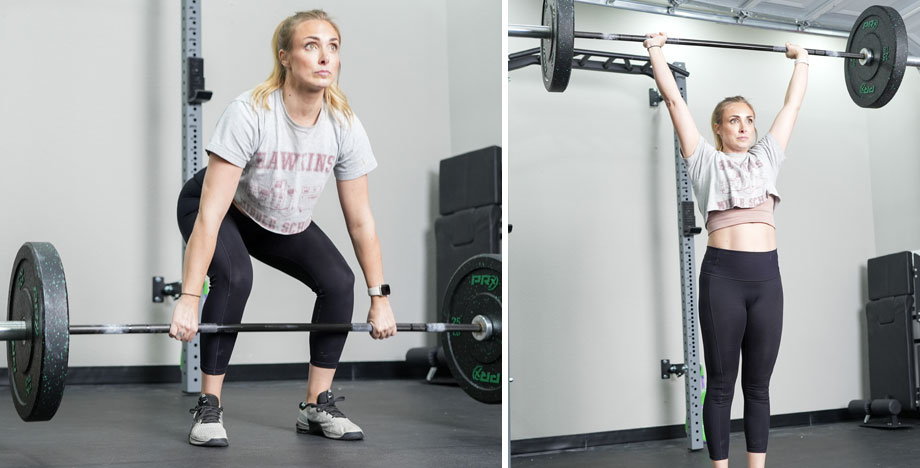
“The jerk is by far one of the more difficult parts of the Olympic lifts, as well as one of my favorites. Not only does the timing of the dip and drive off the shoulders have to be just right, but one must also drive the bar straight overhead; the slightest shift forward or back in the jerk drive can be the difference between a made and missed lift,” says Caine Wilkes, OLY, USAW-L1.
Better Athleticism
Sporting teams, from baseball and football to track and field athletes, will incorporate the clean and jerk and its variations into their training programs. It’s a total body strength and power movement that helps assist them in running faster and jumping higher.
RELATED: Explosive Workouts
Clean and Jerk Variations and Alternatives
The barbell version of the clean & jerk is the one where you will use the most weight, but there are variations and alternatives that can prevent training boredom and overuse injuries or allow you to develop the proper technique before attempting a barbell clean and jerk.
Dumbbell Clean and Jerk
Why do it: The dumbbells provide more freedom of movement than the barbell and will help strengthen imbalances between sides as each dumbbell is lifted separately.
How to do it:
- Hold a pair of dumbbells with a neutral grip and feet shoulder-width apart.
- Hinge and lower the dumbbells until they are hovering just above the floor.
- Then, extend your knees and hips explosively while jumping up and raising your shoulders.
- Dip underneath the dumbbells, catching them in the front rack position, and stand up.
- Smoothly dip your knees, keep your torso upright, and drive through your heels to press overhead. Keep a slight bend in your knees while pressing overhead.
- Slowly return to the starting position, reset, and repeat.
RELATED: Best Dumbbells
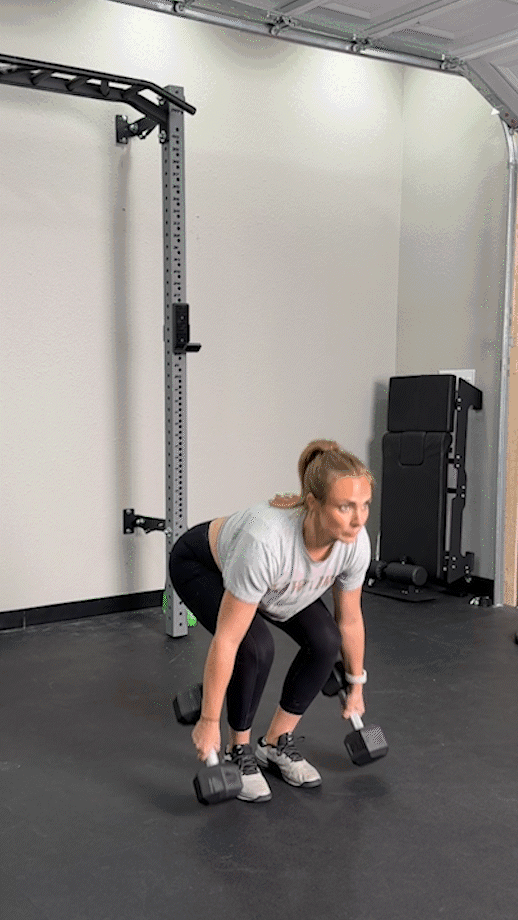
Clean and Press
Why do it: The clean & press is less technical than the jerk and is excellent for the beginner to build some serious overhead strength.
How to do it:
- Stand with a barbell on the ground two inches from your shins.
- Position your feet hip-width apart and hinge toward the barbell.
- Take an overhand shoulder-width hook grip with your shoulders down and chest up.
- Deadlift the barbell off the floor and snap your hips so the bar flies upward, keeping the barbell close to you at all times.
- Dip the knees and catch the bar in the front rack position with your elbows pointed forward.
- From there, squat down for momentum and perform an overhead press.
- Return to the starting position slowly, reset, and repeat for desired reps.
RELATED: Clean and Press Workout
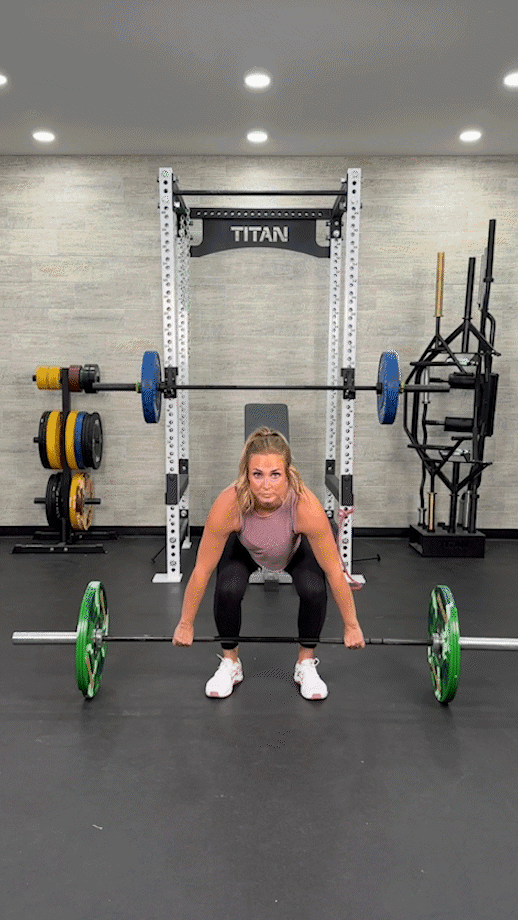
Clean High Pull
Why do it: The clean high pull will help people benefit from power exercises, like the clean and jerk, without the risk of injury due to lack of experience.
How to do it:
- Stand with your shins almost touching a weighted barbell with feet shoulder-width apart.
- Squat and grip the bar with a hook overhand grip wider than shoulder-width apart. Your shoulders should be over the bar with your back arched.
- Start by lifting up from the squat by extending your hips and knees.
- Raise your shoulders once the bar reaches your knees while keeping it close to your body.
- Once the bar is past your knees, raise your heels and pull the barbell towards your chest with your elbows pointed out to the sides.
- Reverse to the starting position by slowing the bar’s descent as you let it fall, reset, and repeat.
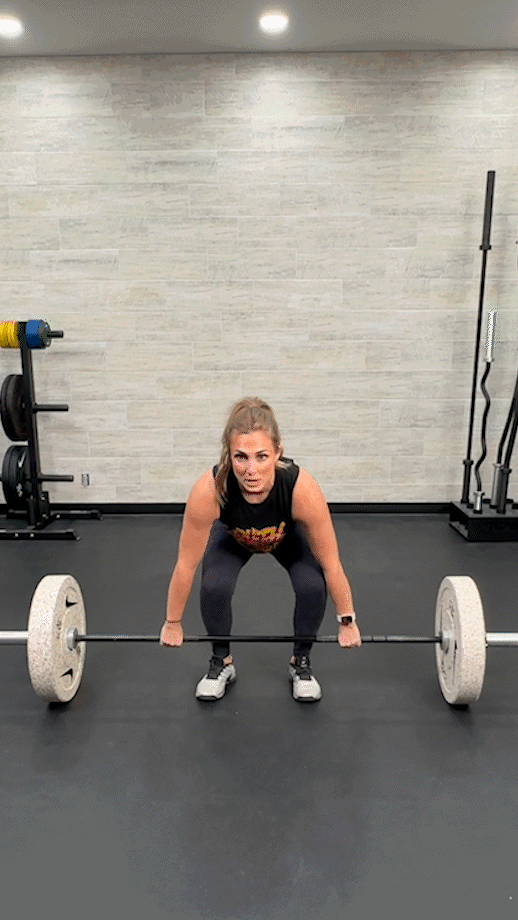
Clean and Jerk: FAQs
What is a good beginner, clean and jerk?
In my opinion, a good weight range that a beginner should strive for with the barbell clean and jerk is between 60 to 160 pounds. If you’re looking for personalized recommendations for weight and form, consider utilizing the training expertise of a personal trainer or strength coach.
RELATED: Best Online Personal Trainers
What is the difference between a clean and jerk and clean and press?
The difference between the clean and jerk and the clean and press is how you press the weight overhead, as the clean part is the same for both exercises. The clean and press uses upper body strength, while the clean and jerk is more of an explosive power exercise that involves leg drive.
Will clean and jerk build muscle?
The clean and jerk will build serious strength and muscle in your glutes, quads, and upper back because you can progressively load each of those muscles for improved muscle and strength.
RELATED: What is Progressive Overload?
Further reading

TheTexas All American Barthe first general-purpose barbell produced by Buddy Capps, the company behind the legendary Texas Power Bar. Utilizing a similar construction and material list as the Texas Power Bar, the All American Barbell features a more passive knurl to allow things like barbell cycling. Although the Texas All American Bar isn't the best bar we've reviewed, the price, features, and quality make it a bar that we can easily recommend. Read more

Running enthusiasts have been debating treadmill vs. outside running for decades. A former track coach and athlete breaks down the pros and cons of each. Read more

Black Friday elliptical deals don’t have to be as elusive as Bigfoot. Check out GGR’s comprehensive list of the best elliptical sales. Read more

You may have seen the clean and jerk in a CrossFit box or watched an Olympic weightlifting competition on TV or in person. It’s one of the two official Olympic lifts used in competition (the other being the snatch exercise). So, how is it done? Essentially, the lifter explosively moves a heavy barbell from the floor to the front rack position and ends in the overhead position using the push press exercise for momentum. » Read more about: How to Clean and Jerk: Lift Like an Olympian » Read more

